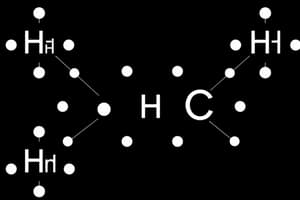Podcast
Questions and Answers
What is the primary purpose of atoms combining with one another?
What is the primary purpose of atoms combining with one another?
- To form metallic bonds
- To become gas-like
- To achieve a more stable electron configuration (correct)
- To increase their mass
What are Lewis Dot Symbols used to track in chemical reactions?
What are Lewis Dot Symbols used to track in chemical reactions?
- Total mass of reactants
- Types of chemical bonds formed
- Temperature changes
- Valence electrons of the atoms (correct)
Which bond is characterized by the sharing of electron pairs between two atoms?
Which bond is characterized by the sharing of electron pairs between two atoms?
- Ionic Bond
- Covalent Bond (correct)
- Hydrogen Bond
- Metallic Bond
What is an ionic bond primarily defined as?
What is an ionic bond primarily defined as?
According to the Octet Rule, which of the following is true for atoms other than hydrogen?
According to the Octet Rule, which of the following is true for atoms other than hydrogen?
What type of bond is characterized by two atoms sharing two pairs of electrons?
What type of bond is characterized by two atoms sharing two pairs of electrons?
What does the electron-sea model describe?
What does the electron-sea model describe?
Which elements can Lewis Dot Symbols not be simply written for?
Which elements can Lewis Dot Symbols not be simply written for?
What is the primary factor determining whether a substance is a solid or a gas at room temperature?
What is the primary factor determining whether a substance is a solid or a gas at room temperature?
Which intermolecular force is generally the strongest?
Which intermolecular force is generally the strongest?
Which type of molecular interaction occurs in non-polar substances?
Which type of molecular interaction occurs in non-polar substances?
Which of the following is an example of a molecule with an expanded octet?
Which of the following is an example of a molecule with an expanded octet?
What type of molecules typically have incomplete octets?
What type of molecules typically have incomplete octets?
What is the characteristic feature of London dispersion forces?
What is the characteristic feature of London dispersion forces?
How many electrons are present in the nitrogen and oxygen in nitrogen monoxide (NO)?
How many electrons are present in the nitrogen and oxygen in nitrogen monoxide (NO)?
What describes molecules that contain an odd number of electrons?
What describes molecules that contain an odd number of electrons?
What is the primary characteristic of a covalent bond?
What is the primary characteristic of a covalent bond?
Which of the following compounds contains only covalent bonds?
Which of the following compounds contains only covalent bonds?
How are the electrons shared in a polar covalent bond?
How are the electrons shared in a polar covalent bond?
Which molecule is an example of a pure covalent bond?
Which molecule is an example of a pure covalent bond?
What defines a triple bond between two atoms?
What defines a triple bond between two atoms?
What direction does the bonding character shift as the electronegativity difference increases?
What direction does the bonding character shift as the electronegativity difference increases?
What are lone pairs in the context of covalent bonding?
What are lone pairs in the context of covalent bonding?
Which statement correctly describes bond length?
Which statement correctly describes bond length?
What kind of reaction is represented by the equation $2Ca + O_{2} \rightarrow 2CaO$?
What kind of reaction is represented by the equation $2Ca + O_{2} \rightarrow 2CaO$?
What is electronegativity primarily related to?
What is electronegativity primarily related to?
What type of intermolecular force primarily holds polar molecules together?
What type of intermolecular force primarily holds polar molecules together?
Where on the periodic table would you typically find elements with high electronegativity?
Where on the periodic table would you typically find elements with high electronegativity?
What characterizes the interaction in an ionic bond?
What characterizes the interaction in an ionic bond?
How does electronegativity generally trend across a period in the periodic table?
How does electronegativity generally trend across a period in the periodic table?
What happens to electronegativity within a group as atomic number increases?
What happens to electronegativity within a group as atomic number increases?
Who devised a method for calculating the relative electronegativities of elements?
Who devised a method for calculating the relative electronegativities of elements?
Flashcards are hidden until you start studying
Study Notes
Chemical Bonding
-
Atoms combine to achieve a more stable electron configuration, similar to a noble gas.
-
A chemical bond is the force holding atoms together in molecules and ions.
Lewis Dot Symbols
- Lewis dot symbols represent valence electrons using dots around an element's symbol.
- Elements in the same group have similar Lewis dot symbols due to similar outer electron configurations.
- The octet rule states that atoms tend to form bonds to have eight valence electrons.
Bond Properties
-
Bond Type:
- Ionic: electrostatic force holding ions together (e.g., NaCl, LiF).
- Covalent: electrons shared between two atoms (e.g., F-F, H-H, CH4).
- Metallic: valence electrons move freely in a "sea" of electrons, holding metal ions together.
-
Bond Degree:
- Single: two atoms share one electron pair.
- Double: two atoms share two electron pairs.
- Triple: two atoms share three electron pairs.
- Double and triple bonds are considered multiple bonds.
-
Bond Length: distance between bonded nuclei.
- Triple bonds are shorter than double bonds, which are shorter than single bonds.
-
Bond Energy: energy required to break a bond.
Electronegativity
- Electronegativity is an atom's ability to attract electrons in a bond.
- Higher electronegativity indicates a stronger attraction for electrons.
- Elements with high electronegativity tend to have high electron affinity and high ionization energy.
- Electronegativity increases from left to right across a period and decreases down a group.
- The most electronegative elements are found in the upper right corner of the periodic table.
Ionic Bond
- Occurs due to electrostatic attraction between positively charged ions (cations) and negatively charged ions (anions).
- Example: LiF.
- Formed by the transfer of electrons between atoms.
Covalent Bond
- Electrons are shared between two atoms.
- Can be:
- Pure Covalent (non-polar): equal sharing of electrons (e.g., H2, F2, O2, N2).
- Polar Covalent: unequal sharing of electrons (e.g., HF, CH4, H2O, HCN).
Intermolecular Forces
- Forces between molecules.
- Generally weaker than bond energies.
- Three types:
- London Dispersion Forces: temporary dipoles caused by fluctuating electron distribution.
- Dipole-Dipole Forces: attraction between permanent dipoles in polar molecules.
- Hydrogen Bonding: strong attraction between a hydrogen atom covalently bonded to a highly electronegative atom (like N, O, or F) and a lone pair on another electronegative atom.
Octet Rule Exceptions
- Some molecules do not follow the octet rule:
- Expanded Octet: atoms can have more than eight valence electrons (elements in period 3 and beyond).
- Incomplete Octet: atoms can have less than eight valence electrons (generally with B, Be, and H).
- Odd Number of Electrons: rare, unstable molecules with an odd number of electrons (e.g., NO).
Studying That Suits You
Use AI to generate personalized quizzes and flashcards to suit your learning preferences.




